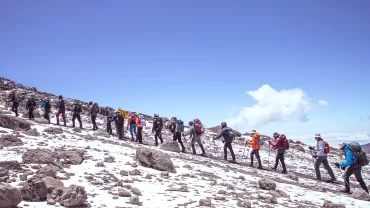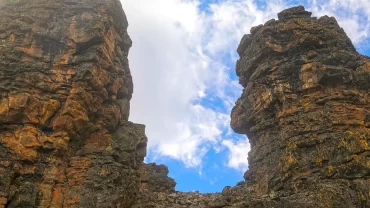Essential Medical Precautions
Climbing Mount Kilimanjaro is a physically demanding endeavor, and proper preparation is necessary to ensure both safety and success. Anyone attempting the climb should undergo a comprehensive medical check-up before embarking on this high-altitude adventure. St Dismass Kilimanjaro Experience (DKE), we strongly recommend that all climbers, particularly those over 40 or with pre-existing health conditions, consult a physician to assess their fitness for the trek.
1. Importance of a Pre-Climb Medical Checkup
Kilimanjaro’s ascent is physically taxing, with changing elevations, cold temperatures, and decreasing oxygen levels. A medical examination ensures that you are physically prepared for the 6-9 days of intense trekking required to reach the summit. Your physician will evaluate your cardiovascular health, lung function, and overall endurance, ensuring you can handle the strain of a high-altitude climb.
Some medical conditions, such as high blood pressure, asthma, diabetes, or heart disease, require special precautions. If you have a pre-existing condition, your doctor may recommend additional medications, fitness training, or altitude sickness prevention strategies.
Who Should Get a Medical Checkup?
Individuals planning to climb Kilimanjaro should prioritize a medical checkup, especially if they fall into any of the following categories:
- 40 years and older
- Individuals with cardiovascular conditions, such as high blood pressure, prior heart attacks, or arrhythmias.
- Those with respiratory issues, including asthma, COPD, or past lung infections.
- Climbers with a history of altitude sickness, as prior reactions can indicate higher susceptibility.
- Individuals who have undergone recent surgeries or have chronic medical conditions that may affect endurance or altitude adaptation.
Key Tests & Evaluations to Consider
A general health screening is advisable, but the following specific tests can help determine your readiness:
- Cardiovascular assessment: Evaluates heart health and endurance under physical stress.
- Lung function tests: Especially important for individuals with respiratory conditions.
- Blood pressure and oxygen saturation monitoring: Ensures stable circulation and oxygen levels.
- Fitness evaluation: Assesses endurance and physical stamina needed for the climb.
For further insights on preparing physically, read Getting Ready to Conquer the Climb.
2. Understanding the Risks of High-Altitude Trekking
Ascending to 5,895 meters (19,341 feet) at the summit of Kilimanjaro exposes climbers to altitude-related illnesses due to reduced oxygen levels. Understanding these risks and knowing how to recognize symptoms early is crucial for a safe and successful climb.
Common Symptoms of Mild Altitude Sickness
Mild altitude sickness is common and usually manageable if addressed early. Symptoms include:
- Mild headaches and dizziness.
- Shortness of breath, particularly during exertion.
- Fatigue and disturbed sleep patterns.
- Loss of appetite and mild nausea.
Severe Altitude Sickness: Recognizing Dangerous Symptoms
While mild altitude sickness can be managed with rest and hydration, severe altitude sickness can be life-threatening.
- Acute Mountain Sickness (AMS): Nausea, dizziness, vomiting, and persistent headaches that worsen over time.
- High-Altitude Pulmonary Edema (HAPE): Fluid buildup in the lungs, leading to extreme breathlessness, chest tightness, and a dry cough.
- High-Altitude Cerebral Edema (HACE): Brain swelling causing confusion, loss of coordination, and disorientation.
If symptoms of HAPE or HACE develop, immediate descent is necessary. Our experienced DKE guides monitor climbers closely and are trained to initiate rapid response measures.
For detailed information on altitude adaptation, see Acclimatization on Kilimanjaro.
3. The Role of Diamox in Altitude Sickness Prevention
Acetazolamide (Diamox) is a widely used medication that helps climbers acclimate more effectively by stimulating deeper breathing and reducing the symptoms of altitude sickness. While not mandatory, many climbers find it beneficial in preventing Acute Mountain Sickness (AMS) and alleviating discomforts such as headaches, dizziness, and nausea.
It is crucial to consult your doctor before using Acetazolamide. Your doctor can assess whether it is suitable for you, discuss potential side effects, and recommend the appropriate dosage based on your medical history and individual health needs.
Who Should Consider Taking Diamox?
Diamox may be recommended for climbers who:
- Have a history of altitude sickness.
- Experience headaches or dizziness at moderate altitudes.
- Want additional protection against altitude-related symptoms.
How to Use Diamox for Kilimanjaro
Always consult with your doctor before using Diamox.
4. Travel Insurance: A Non-Negotiable Requirement
Having comprehensive travel insurance is mandatory for all climbers. Kilimanjaro as any other high altitude mountain you can’t predict when you may require emergency evacuation, medical care, or trip cancellation coverage. A good travel insurance policy should include:
- High-altitude trekking coverage above 5,000 altitude metres.
- Emergency medical evacuation and rescue services.
- Hospitalization and treatment costs in Tanzania.
- Trip cancellations, delays, or lost baggage compensation.
Why Travel Insurance is Essential for Kilimanjaro
As DKE we highly recommend that all our guests should have travel insurance that can cover above 5000 altitude metres while the Flying Doctors evacuation service covers aerial rescue costs, hospitalization expenses are not included. Without proper insurance, medical costs can become prohibitively expensive, making it crucial to secure a policy before departure.
For details on responsible travel planning, check out How Dismass Kilimanjaro Supports Sustainable Travel.
5. Pre-Departure Health Form & Final Checklist
Before starting your Kilimanjaro trek, all climbers must complete a medical assessment form and submit it to DKE. This helps our team understand any pre-existing health conditions, allergies, medications, and dietary restrictions, allowing us to offer the necessary support and ensure a safe and well-managed trekking experience on the mountain.
Essential Pre-Departure Steps:
- Medical Clearance: Visit your doctor and confirm your readiness for high-altitude trekking.
- Vaccinations: Obtain necessary vaccines such as Yellow Fever, Hepatitis A/B, and Typhoid.
- Travel Insurance: Secure a policy that includes evacuation and medical coverage.
- Medications: Pack altitude sickness prevention, pain relievers, and personal prescriptions.
- Complete DKE Medical Form: Send the completed form to us before departure.
For a complete gear and packing checklist, download: The Ultimate Tanzania Adventure Packing List.
Final Thoughts: Prioritize Your Health for a Safe Summit
Preparing for Kilimanjaro’s physical and altitude challenges starts with a thorough medical evaluation, securing insurance, and following safety guidelines. By ensuring that you are fit for the climb and taking proactive precautions, you significantly improve your chances of reaching Uhuru Peak safely.
At Dismass Kilimanjaro Experience, we are committed to your health, safety, and successful ascent. Let’s work together to make your Kilimanjaro adventure a life-changing and safe experience!
For additional resources, explore:
- Life Above the Clouds: What to Expect at Kilimanjaro’s Summit
- The Best Time to Go on a Safari in Tanzania
- Combining Adventure and Luxury in Tanzania
Ready to prepare for your Kilimanjaro expedition? Contact us today and let’s make your dream climb a reality!





Comment (0)